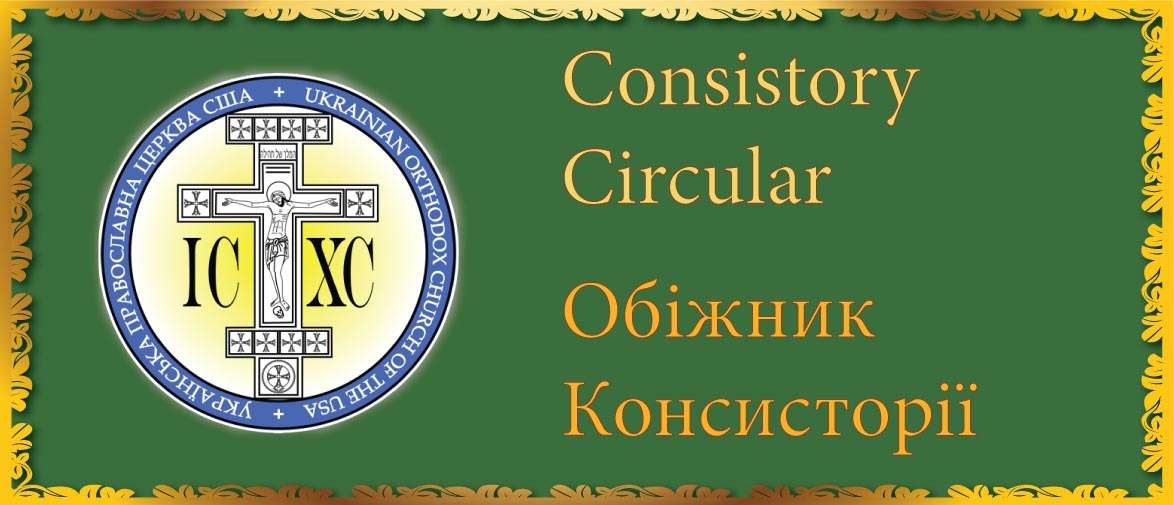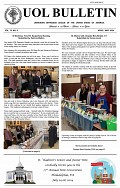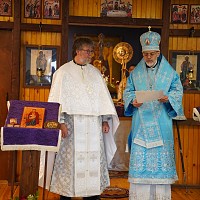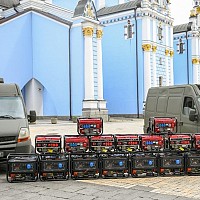A Lesson for Healing the Divisions among Us
Turning Saints into Symbols – the examples of Peter and Paul
While we may be surprised to see such behavior among Christians, it is nothing new. In fact, Christians have even gone so far as to claim patrons from among the saints – and even Christ Himself - as proponents of their fallen notions. Let me give you an example from today's feast. One of the things that created divisions (and eventual schism) within the Church was an argument over who had the power to decide matters of faith and direction. The Romans, seeking to bolster the centrality and power of their pope, turned Saint Peter into the patron of their cause, reading into his life proof that their position on (Roman) Papal Primacy was the only correct and natural one. When we read such claims, we learn more about Roman Catholic doctrine and its defenders than we do about the actual life and ministry of St. Peter. He was clearly the “first among equals”, but the rock of his confession and the keys to the kingdom were not uniquely his, but the salvific witness and ministry of the Church.
A similar thing can be done with St. Paul, the “Apostle to the Gentiles”. For converts (or anyone seeking to avoid assimilation into a foreign culture), this great evangelist can become their patron, protecting them from the ethnophyletic evil being imposed on them by people who are obviously more concerned with the preservation of culture and nationalism than the spreading the Gospel. St. Paul's defense and promulgation of a non-Jewish Orthodoxy makes him an ideal figurehead for local expressions of Orthodoxy everywhere. [Using Galatians 2:11] They can even manufacture a schism between their great champion – the “Apostle to the Gentiles” and St. Peter over this issue. But, once again, we learn more about the storytellers and their agenda than what was really going on. Just as closer reading of Scripture leads us to reject the Roman claims about the Pope of Rome, it also leads us away from these artificial creations: St. Paul was an evangelist to Jews as well as Gentiles (remember, he had Timothy circumcised), and St. Peter baptized Gentiles and gave testimony at the Apostolic Council in Jerusalem in support of St. Paul's position. More on this in a moment.
Avoiding propaganda and seeing things for what they really are may not solve difficult issues involving nationalism, multiculturalism, and autocephaly, but it can certainly re-frame the discussion in a way that re-enforces our unity rather than foments division. This is what the lives of Saints Peter and Paul really teach us. They were not symbols of any cause, but living instruments of God's will. It is worth noting that they did not begin that way. In fact, they began their ministries as guilty of spin and deception as any among us now. Let's look at that and how they were transformed into the righteous men we celebrate today.
The Kenosis of Saint Peter
St. Peter, a simple and straightforward man, was one of the first followers of Christ, but the Christ that he had created in his mind was not the real Christ; it was a symbol of things that he himself wanted. The hymns for today's feast remind us that even after his great confession; “thou art the Christ (Messiah), Son of the Living God”, he fell prey to his own delusions. For Saint Peter (as for all of us), becoming a saint was less about getting rid of false opinions and learning/reinforcing correct ones, than about emptying himself completely in the service of Christ. Just as Christ had not considered being God something to be held onto (Philippians 2:6) and had radically emptied Himself to become man for the sake of our salvation; so, too, would Peter have to empty himself to participate in this very salvation. While Jesus had been preparing Peter for this throughout their time together (e.g. “get thee behind me Satan” - St. Matthew 16:23; “Do you love me more than these..” - St. John 21:15), you really see this process in action as he repented following his denial of Christ before his passion. This seems to be when Peter really began emptying himself of his own agenda and allowing God's will and work to fill him. But some prejudices of his former mind remained, most notably when it came to doing God's work among the Gentiles.
An Interlude on the Jews and Gentiles at the time of the Acts of the Apostles
The culture of the Jews was one of separateness. This culture had been ordained by law (even seemingly random laws such as the prohibition on mixing types of fabric in one garment should be seen in this light) and reenforced by the (seemingly secular) need to preserve the Jewish identity against the assimilating empires that ruled over them. The Jews of the Apostolic Church had accepted Christ and His radical message of transformation, but cultures take a long time to change. There was also the practical matter that they still needed to resist assimilation by the Roman empire and their Jewish culture had already shown itself to be up to the task. Why mess with a good thing? The Way to perfection was naturally described and lived according to Jewish tradition, albeit fulfilled in Christ and baptized by the Holy Spirit. For these reasons and more, the instinct for Jewish separateness remained.
But what about the Gentiles? Christ commanded that the Gospel be brought to all nations (e.g. St. Matthew 28:19), but what did that mean in practical terms? The issue of conversion had long been controversial among the Jews. During the period of the Second Temple (to include the time period under consideration) the category of “God-fearer”, attests in large part to the desire of Jews to retain their separateness (as does the very retention of the term “proselyte”, even for those who had completely given themselves over to Jewish law). This was the “default” setting for the purists among the early Christians: converts must either assimilate as Jews or remain outside their community. And even having converted, there were strong pressures to keep the communities separate (thus Galatians 2:11). Saints Peter and Paul were part of this milieu, and it is here that their lives become so instructive.
The Continuing Kenosis of Saint Peter
In his early Apostolic ministry, St. Peter had completely submitted himself to Christ and His Gospel, but he still lived within the Jewish paradigm, keeping himself separate from the Gentiles and living as a Christian (i.e. “Messianic”) Jew. This began to change when God called him to bring the Gospel to the home of Cornelius, a Roman God-fearer. To prepare St. Peter for this ministry, God led him to question his Jewish paradigm by sending a dream that blessed him to eat foods that Jews considered unclean and defiling (Acts 10). God further challenged this paradigm when the Holy Spirit moved among those of Cornelius' Gentile home just as He had among Peter and his fellow Jews (ibid). At that point, St. Peter knew that it was right and fitting that these Gentiles be brought completely into the Mysteries of the Church without requiring them to be circumcised or otherwise converted to Judaism. As I mentioned earlier, St. Peter defended this action at the first Apostolic Council which had been convened to decide the propriety of similar actions by St. Paul among in Antioch (among other places). Through this process, Saint Peter was further emptied of his former delusion and made a more perfect vessel of God.
The Kenosis of Saint Paul
Which brings us to St. Paul. As Saul, he had been trained as a Pharisee and had lived the life of a devout Jew. Like St. Peter, he had his own ideas about Jesus Christ. For him, Christ was a symbol of dangerous heresy. Saul dedicated himself to persecuting Christ's followers and preserving the faith of his fathers. Renamed Paul, he surrendered this identity after his conversion (e.g. Philippians 3:4-6), emptying himself and sacrificing his ego. Like St. Peter, he put to death his old man (e.g. Romans 6; St. Luke 14: 25-27) and lived a new life, even going so far to say that it was no longer he who lived, but Christ who lived in him (e.g. Galatians 2: 20). Through this, St. Paul was transformed into an evangelical chameleon, “becoming all things to all men” so that they might hear the Gospel and be saved (1 Corinthians 9: 19-23). St. Paul worked within the culture of the Gentiles, teaching them about Christ using their own language and their own symbols (e.g. Acts 17: 22-28). Through this, the wall of separation between nations was torn down and all to be united into the one nation of Christ (Ephesians 2: 14-18).
Conclusion: so what does that mean for us?
So what does all this have to do with us and our recent unpleasantness? First, we have to remember that there are many people who boast not of their own infirmities (2 Corinthians 12: 5) or the cross of Christ (Galatians 6: 14), but of the righteousness of their own narrow cause. They turn everything they see, bishops, saints, even Christ Himself, into symbols (both positive and negative) that reinforce their own opinions. We learn more about them and their agendas from their stories than we do about the people and events they describe. Second, we ourselves must learn to see people and events in the pure and objective light of Christ rather than according to the light of our own purposes. The light of Christ illumines all, but the eyes of our own imaginations are bad and spread nothing but darkness and folly (St. Matthew 6: 23; and it is surely better to pluck out such an eye rather than to become an agent of sin – St. Matthew 5: 29). Until we see everything according to its true nature and purpose (and who are we to judge our own vision!?) we should approach all arguments with humble skepticism and remember that we really only need to know one thing (St. Luke 10: 42), and that thing can be known by all with eyes to see and ears to hear. Thirdly, we can follow the examples of Saints Peter and Paul and empty ourselves of delusion. Their kenosis did granted them true discernment and, more to the point, turned them into instruments of the grace of God. And that, my dear brothers and sisters, is far more beneficial for both them and us than becoming the symbols or spokesperson for any other cause, no matter how grand or noble.
And Christ turned and said to them; “if any man comes to me, and hates not his father, and mother, and wife, and children, and brothers, and sisters, yea, and his own life also, he cannot be my disciple. And whosoever does not bear his cross and come after me, cannot be my disciple.” (St. Luke 14:25-27)
V. Rev. Anthony Perkins
Holy Resurrection Mission, Waynesville, NC
|
| |||||||||||||












